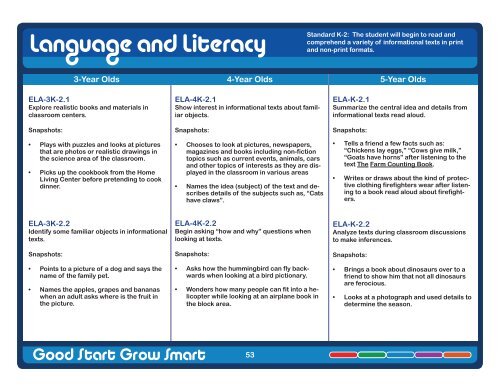Good Start, Grow Smart Early Learning Standards - SC Department ...
Good Start, Grow Smart Early Learning Standards - SC Department ...
Good Start, Grow Smart Early Learning Standards - SC Department ...
You also want an ePaper? Increase the reach of your titles
YUMPU automatically turns print PDFs into web optimized ePapers that Google loves.
3-Year Olds 4-Year Olds 5-Year Olds<br />
ELA-3K-2.1<br />
Explore realistic books and materials in<br />
classroom centers.<br />
Snapshots:<br />
•<br />
•<br />
Plays with puzzles and looks at pictures<br />
that are photos or realistic drawings in<br />
the science area of the classroom.<br />
Picks up the cookbook from the Home<br />
Living Center before pretending to cook<br />
dinner.<br />
ELA-3K-2.2<br />
Identify some familiar objects in informational<br />
texts.<br />
Snapshots:<br />
•<br />
•<br />
Points to a picture of a dog and says the<br />
name of the family pet.<br />
Names the apples, grapes and bananas<br />
when an adult asks where is the fruit in<br />
the picture.<br />
ELA-4K-2.1<br />
Show interest in informational texts about familiar<br />
objects.<br />
Snapshots:<br />
•<br />
•<br />
Chooses to look at pictures, newspapers,<br />
magazines and books including non-fiction<br />
topics such as current events, animals, cars<br />
and other topics of interests as they are displayed<br />
in the classroom in various areas<br />
Names the idea (subject) of the text and describes<br />
details of the subjects such as, “Cats<br />
have claws”.<br />
ELA-4K-2.2<br />
Begin asking “how and why” questions when<br />
looking at texts.<br />
Snapshots:<br />
•<br />
•<br />
Asks how the hummingbird can fly backwards<br />
when looking at a bird pictionary.<br />
Wonders how many people can fit into a helicopter<br />
while looking at an airplane book in<br />
the block area.<br />
53<br />
Standard K-2: The student will begin to read and<br />
comprehend a variety of informational texts in print<br />
and non-print formats.<br />
ELA-K-2.1<br />
Summarize the central idea and details from<br />
informational texts read aloud.<br />
Snapshots:<br />
•<br />
•<br />
Tells a friend a few facts such as:<br />
“Chickens lay eggs,” “Cows give milk,”<br />
“Goats have horns” after listening to the<br />
text The Farm Counting Book.<br />
Writes or draws about the kind of protective<br />
clothing firefighters wear after listening<br />
to a book read aloud about firefighters.<br />
ELA-K-2.2<br />
Analyze texts during classroom discussions<br />
to make inferences.<br />
Snapshots:<br />
•<br />
•<br />
Brings a book about dinosaurs over to a<br />
friend to show him that not all dinosaurs<br />
are ferocious.<br />
Looks at a photograph and used details to<br />
determine the season.


